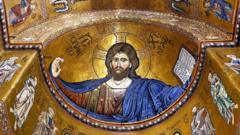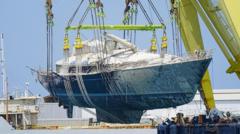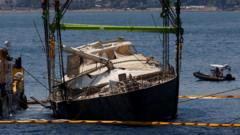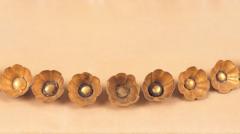The cathedral's vibrant mosaics, adorned with gold and extensive artwork, have undergone careful restoration, reinforcing their status as a UNESCO World Heritage site.
**Restoration of Monreale Cathedral's Mosaics Revives Italy's Artistic Heritage**

**Restoration of Monreale Cathedral's Mosaics Revives Italy's Artistic Heritage**
A remarkable restoration project in Sicily has brought Italy's largest medieval mosaics back to life, highlighting their historical significance and beauty.
In a stunning culmination of art and history, the Monreale Cathedral, located in Sicily on a hill overlooking Palermo, has recently undergone a meticulous restoration process. Officially recognized as a UNESCO World Heritage Site since 2015, this 12th-century architectural marvel features Italy's most extensive Byzantine-style mosaics, a breathtaking collection that ranks second in the world only to those found at Hagia Sophia in Istanbul.
Spanning over an impressive 6,400 square meters, these mosaics are not only a visual feast but are also embellished with approximately 2.2 kilograms of pure gold. The original intention behind their creation was to inspire awe and humility among visitors as they processed through the grand central nave, reminiscent of the artistic trends established in Constantinople, the epicenter of the Byzantine Empire.
The extensive restoration was labor-intensive and time-consuming, taking over a year to complete. During this period, the cathedral became a hive of activity, with construction scaffolding enveloping its altar and transept. A dedicated team of local experts from the Italian Ministry of Culture meticulously initiated the restoration by removing layers of dust that had settled on the mosaics over the years, followed by repairing damaged tiles, some of which had lost their lustrous enamel and gold leaf.
Father Nicola Gaglio, a priest with a 17-year tenure at Monreale, expressed his deep investment in the process, likening it to a father’s care. "The team approached this work almost on their tiptoes," he revealed. He recounted challenges encountered, such as uncovering a yellowed varnish on the ceiling that needed to be stripped away, likening it to peeling cling film.
In addition to restoring the mosaics, the renovation involved the installation of a new lighting system. Matteo Cundari, the Country Manager of Zumtobel, emphasized the need for a more effective solution to illuminate the artworks, noting the high energy costs of the previous system. The new setup aims to enhance the beauty of the mosaics while maintaining reversibility for future upgrades.
Costs for the first phase of the restoration amounted to approximately 1.1 million euros, with plans underway for a second phase targeting the central nave. Father Gaglio expressed overwhelming joy at witnessing the mosaics reveal their glorious beauty under improved lighting, remarking, "It's pure beauty." He emphasized the profound responsibility inherent in safeguarding such a precious piece of world heritage, urging society to cherish the beauty that reminds us of our humanity.
Ultimately, the restoration of Monreale Cathedral's mosaics has rekindled appreciation for this hidden gem of Italian heritage and serves as a beacon of artistic splendor amidst a world that craves beauty and inspiration.
Spanning over an impressive 6,400 square meters, these mosaics are not only a visual feast but are also embellished with approximately 2.2 kilograms of pure gold. The original intention behind their creation was to inspire awe and humility among visitors as they processed through the grand central nave, reminiscent of the artistic trends established in Constantinople, the epicenter of the Byzantine Empire.
The extensive restoration was labor-intensive and time-consuming, taking over a year to complete. During this period, the cathedral became a hive of activity, with construction scaffolding enveloping its altar and transept. A dedicated team of local experts from the Italian Ministry of Culture meticulously initiated the restoration by removing layers of dust that had settled on the mosaics over the years, followed by repairing damaged tiles, some of which had lost their lustrous enamel and gold leaf.
Father Nicola Gaglio, a priest with a 17-year tenure at Monreale, expressed his deep investment in the process, likening it to a father’s care. "The team approached this work almost on their tiptoes," he revealed. He recounted challenges encountered, such as uncovering a yellowed varnish on the ceiling that needed to be stripped away, likening it to peeling cling film.
In addition to restoring the mosaics, the renovation involved the installation of a new lighting system. Matteo Cundari, the Country Manager of Zumtobel, emphasized the need for a more effective solution to illuminate the artworks, noting the high energy costs of the previous system. The new setup aims to enhance the beauty of the mosaics while maintaining reversibility for future upgrades.
Costs for the first phase of the restoration amounted to approximately 1.1 million euros, with plans underway for a second phase targeting the central nave. Father Gaglio expressed overwhelming joy at witnessing the mosaics reveal their glorious beauty under improved lighting, remarking, "It's pure beauty." He emphasized the profound responsibility inherent in safeguarding such a precious piece of world heritage, urging society to cherish the beauty that reminds us of our humanity.
Ultimately, the restoration of Monreale Cathedral's mosaics has rekindled appreciation for this hidden gem of Italian heritage and serves as a beacon of artistic splendor amidst a world that craves beauty and inspiration.


















